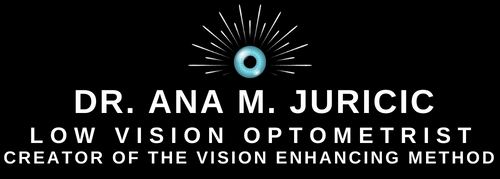What you need to know about anti-glare tints, blue-blocking tints, and sunglasses
Many people living with vision loss can be affected by the outside glare from the sunlight as well as indoor glare from overhead lights and blue wavelengths of light emitted from the screens of digital devices. Anti-glare tinted glasses offer the benefits of minimizing exposure to invisible wavelengths of light that can be damaging to the macula.
The blue blocking lens can help to filter out indoor glare and is designed to provide relief from the uncomfortable side effects associated with staring at screens. It’s common to notice a more soothing comfortable feeling in your eyes when wearing a blue-blocking tinted lens.
Wearing blue-blocking lenses is especially important for patients living with any degree of Macular Degeneration (AMD) or other conditions affecting their macula like Stargardt’s as these antiglare and blue-blocking tints help prevent the scattering of light (glare) at the macular pigment level which can result in damage to these retinal cells.
For people who don't need to wear prescription lenses, fit-over glasses can be a beneficial option. Fitover glasses come in various tints including very light yellow, brighter yellow, orange, darker reddish orange, amber, and grey tints. The fit-overs also shield light from entering above the frame and from the side of the frames. The various yellow, orange and reddish-orange tints filter out blue wavelengths of light at different portions of the spectrum of light.

This minimizes the scattering of light at the macular pigment level which is the area of the eye responsible for the finest detailed vision. Depending on a person’s eye condition, a person may favour one tint more than another.
From my 26 years of experience, I find that about 60% of my patients do appreciate having a blue blocker lens, either pale yellow or brighter yellow because these tints improve contrast while minimizing glare at the same time.
For people who live with eye conditions like albinism, retinitis pigmentosa, cone dystrophy and rod dystrophy, these individuals may find orange tinted lenses more beneficial than the lightly tinted blue blocking lens and the brighter yellow tinted lenses.
Often these individuals may appreciate specialized photochromatic Corning tinted lenses that are a lighter colour indoors and darken outdoors based on the degree of UV light exposure. These individuals may find that the Corning tinted lenses can help them differentiate different degrees of elevation of the sidewalk compared to not wearing the Corning tinted lenses.
On bright sunny days, usually darker sunglasses that are polarized and either amber (brown) or grey in colour are best. The polarized tint will help block any vertical glare from sunlight bouncing back from a horizontal surface like water or snow. A polarized tint will only allow sunlight that comes in horizontally through the lens.
If you are uncertain of which blue blocking, anti-glare, or sunglass tint is best for you, I recommend contacting your eye care professional and asking if they have sample tints that you can try looking through before purchasing.
Watch the following video to get more insights and recommendations from Dr. Ana Juricic


